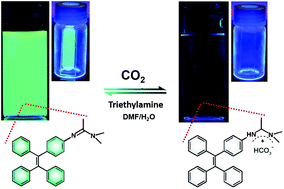Synergy of CO2-response and aggregation induced emission in a small molecule: renewable liquid and solid CO2 chemosensors with high sensitivity and visibility†
Abstract
A tetraphenylethylene (TPE) derivative (N,N-dimethyl-N′-(4-(1,2,2-triphenylvinyl)phenyl)acetimidamide, TPE-amidine) was designed and synthesized, and used to prepare visible CO2 chemosensors, TPE-amidine-L (liquid) and TPE-amidine-S (solid). The hydrophilicity of TPE-amidine thoroughly changed because of the unique reversible reaction between the amidine group and CO2, which controlled the molecular aggregation extent in water by CO2. Combining with the well-known aggregate-induced emission effect, the highly selective CO2 chemosensor TPE-amidine-L was developed, which has the lowest CO2 detection limit of 24.6 ppm compared with other reported CO2 chemosensors, and can be regenerated within 10 s by adding triethylamine. With the aim of being safer and more convenient to use, a polyacrylamide hydrogel containing TPE-amidine was prepared as a renewable CO2 sensing “tape” (TPE-amidine-S). The flexibility, adhesivity, CO2 sensitivity and reversibility of the “tape” is systematically investigated, showing great potential for “on-site” and “real-time” CO2 detection in practical applications.



 Please wait while we load your content...
Please wait while we load your content...